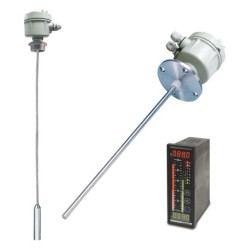

Category


Photos are for informational purposes only. View product specification
please use latin characters
The RF admittance level transmitter uses the capacitance formed between the measuring probe and the reference probe or the metal tank wall to calculate the level of the medium inside the tank based on capacitance theory, where capacitance and tank volume are proportionally increased. When the probe is surrounded by air, a small capacitance (C) is measured by the equivalent capacitor A. The capacitance gradually increases as the medium fills, and the maximum capacitance (C) is measured by capacitor B when the tank is full. The difference (dC) between C and C is proportional to the level between A and B (recommended range for dC = 25-2000 pF).
Main features:
Applications:
Are you interested in this product? Do you need additional information or individual pricing?
The RF admittance level transmitter uses the capacitance formed between the measuring probe and the reference probe or the metal tank wall to calculate the level of the medium inside the tank based on capacitance theory, where capacitance and tank volume are proportionally increased. When the probe is surrounded by air, a small capacitance (C) is measured by the equivalent capacitor A. The capacitance gradually increases as the medium fills, and the maximum capacitance (C) is measured by capacitor B when the tank is full. The difference (dC) between C and C is proportional to the level between A and B (recommended range for dC = 25-2000 pF).
Main features:
Applications:
Your review appreciation cannot be sent
Report comment
Report sent
Your report cannot be sent
Write your review
Review sent
Your review cannot be sent
